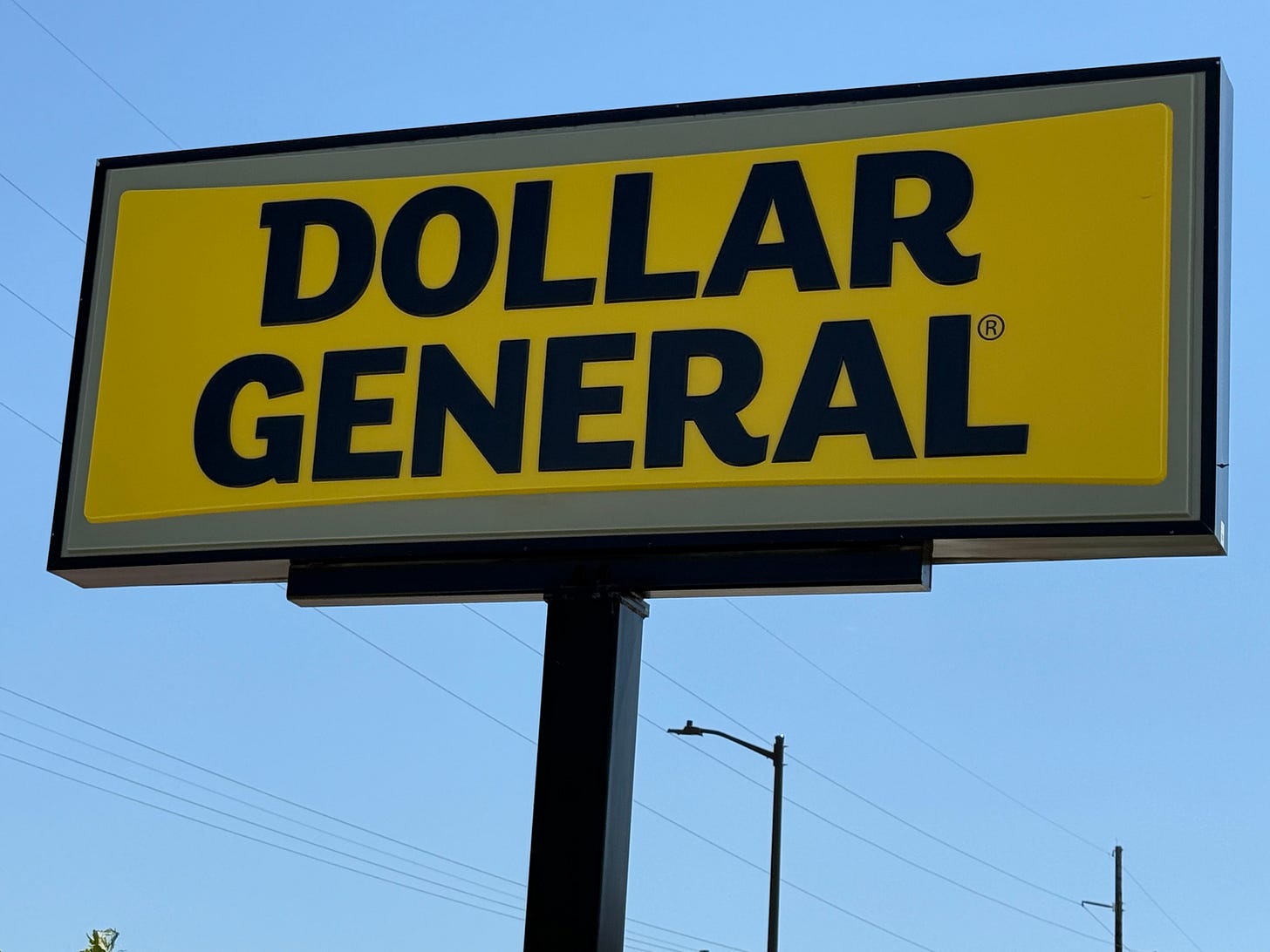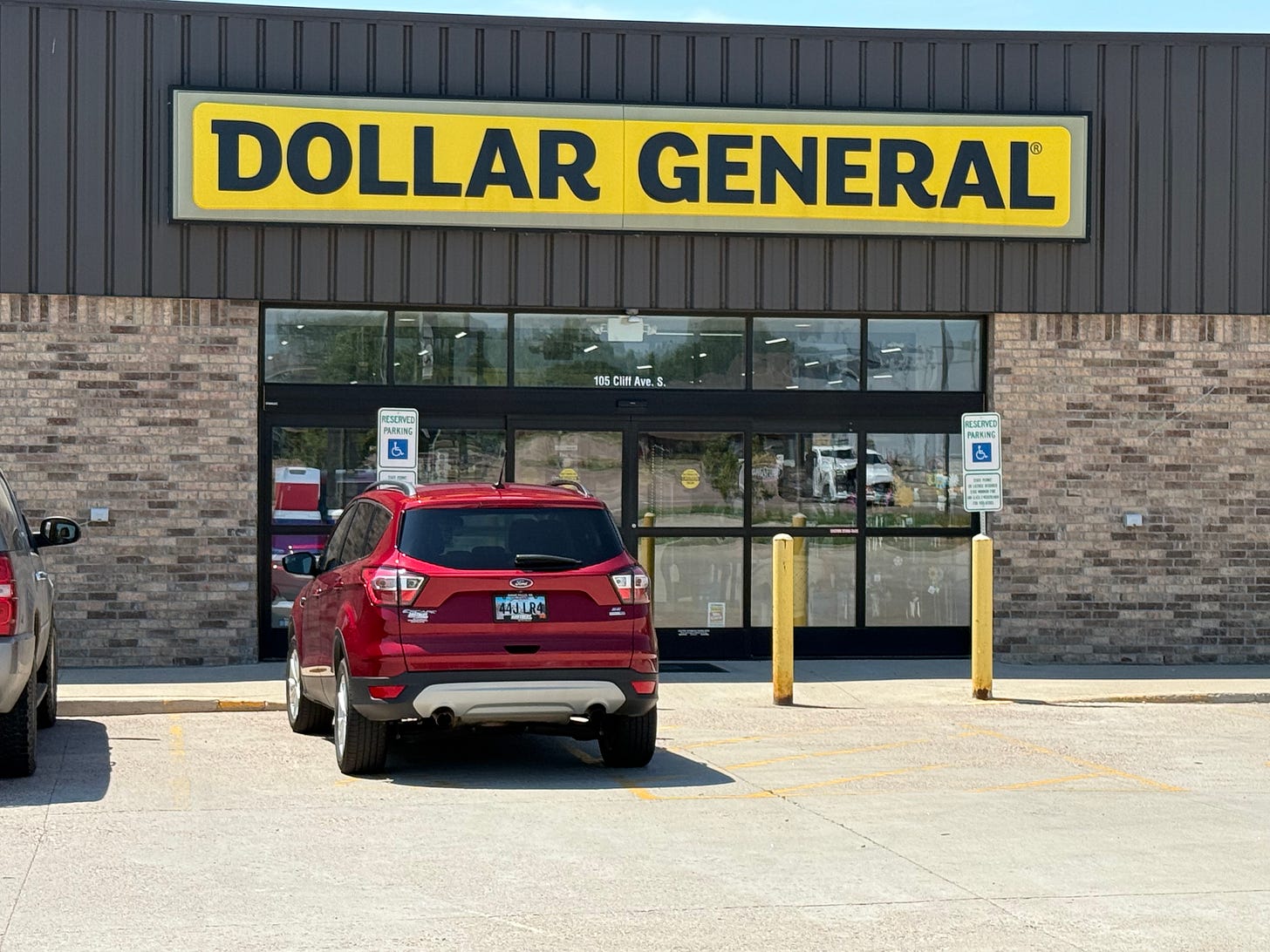Dollar General Expansion Transforms Rural South Dakota Retail Landscape
In Brief: Dollar General Stores Put the Squeeze on Small Town Independent Grocers
Dollar General sign in Harrisburg, S.D. Northern Plains News photos by Todd Epp.
By Todd Epp, Northern Plains News
(Broadcast readers follow the main story.)
HARRISBURG, S.D. — A wave of Dollar General store openings is transforming the retail landscape in small-town South Dakota, bringing affordable goods to rural communities while squeezing independent grocers, eliminating jobs, and contributing to what food security experts call the state's worst hunger crisis in a decade.
The discount chain's rapid expansion — from 52 stores in early 2023 to 71 today — reflects a broader trend reshaping rural commerce across the Midwest, where dollar stores are increasingly becoming the primary retail option in communities too small for traditional supermarkets.
Dollar General's Rural Strategy
Dollar General's growth strategy deliberately targets towns too small for big-box retailers, often becoming the main discount outlet in communities with fewer than 1,000 residents. Company data shows about 80 percent of Dollar General stores nationwide are in communities with fewer than 20,000 people.
The chain's 71 South Dakota locations span from major cities like Aberdeen, Rapid City and Sioux Falls to small towns including Arlington, Belle Fourche, Beresford, Black Hawk, Box Elder, Brandon, Britton, Canton, Chamberlain, Clark, Clear Lake, Colman, Colton, Corsica, Custer, De Smet, Dell Rapids, Edgemont, Elk Point, Eureka, Faith, Faulkton, Flandreau, Freeman, Garretson, Gettysburg, Gregory, Groton, Harrisburg, Hartford, Hermosa, Highmore, Hill City, Hot Springs, Howard, Huron, Ipswich, Kadoka, Lake Andes, Lemmon, Lennox, Madison, Martin, Milbank, Miller, Mobridge, Newell, North Sioux City, Parkston, Plankinton, Platte, Redfield, Salem, Selby, Sisseton, Sturgis, Summerset, Summit, Tea, Volga, Wagner, Watertown, Waubay, Webster, Wessington Springs, White River and Winner.
This extensive geographic footprint reflects the company's focus on underserved rural markets where residents previously drove long distances for basic household goods.
Independent Grocers Feel the Squeeze
Harrisburg, S.D. Dollar General storefront.
The rapid expansion has strained independent grocers throughout the rural Midwest. In neighboring Nebraska, where Dollar General has pursued a similar strategy, the impact on small-town grocers offers a preview of challenges facing South Dakota retailers.
"When a Dollar General opens, we see a drop in foot traffic almost immediately," said Julie Johnson, owner of Nelson's Food Pride in Oakland, Nebraska, told the Flatwater Press. "They can undercut us on price, but they don't offer the fresh produce or community support local stores offer."
This pattern has contributed to nearly 20 percent of small-town grocery stores in Nebraska closing over the past 25 years. Similarly in South Dakota, grocers in towns like Winner and De Smet report declining sales and community concern after Dollar General openings, though no grocery store closure has been directly attributed solely to the chain's arrival.
U.S. Department of Agriculture research supports these anecdotal reports, finding that rural independent grocery stores were nearly three times more likely to close after a new dollar store opened in the same census tract between 2000 and 2019. South Dakota News Watch and South Dakota Public Broadcasting report that while Dollar General's presence adds competitive pressure, grocery closures typically result from multiple factors, including population loss, owner retirements, and thin profit margins.
ShopKo Closures Highlight Retail Vulnerability
The fragility of rural retail became starkly apparent in 2019 when ShopKo, a mid-sized department store chain, abruptly closed six South Dakota locations in Chamberlain, Custer, Dell Rapids, Redfield, Wagner and Webster. Each closure eliminated 15 to 25 jobs and left residents with few local options for groceries and household goods.
South Dakota News Watch reported that analysts and local officials cited the rise of discounters like Dollar General, Dollar Tree, and Family Dollar as a key factor squeezing mid-sized retailers out of business, alongside growth in online shopping and big-box competition.
Economic Impact: Fewer Jobs, Lower Wages
Dollar General's business model relies on low overhead and minimal staffing, creating fewer economic opportunities than traditional retailers. Most Dollar General stores employ six to 10 people — far fewer than the 15 to 30 jobs typically supported by a full-service grocery store.
Current wage data shows Dollar General workers in South Dakota average $16.70 per hour, with store managers earning about $36,440 annually. Industry analysis from The Guardian and Bismarck Tribune confirms this lean staffing approach is central to the company's profitability strategy.
Food Access Concerns Mount
Public health experts and nonprofit groups warn that the shift to dollar stores may worsen food access in rural areas, as these stores rarely carry fresh produce or meat.
A 2018 study by the Augustana Research Institute identified 75 food deserts in South Dakota — areas where 16.9 percent of the state's population lives with limited access to supermarkets. The study links these food deserts to lower income, higher poverty and lower educational attainment.
"There's a lot of need on the South Dakota side as well," said Kim Rockman, executive director of Project Food Forest, referring to food insecurity and food deserts in the region.
The crisis has intensified recently. Feeding South Dakota reports that more than 115,000 people — about one in nine residents — are food insecure, representing the highest rate in a decade. CEO Lori Dykstra told the South Dakota Legislature's Joint Appropriations Committee in May that federal funding cuts mean "over 325,000 meals have been discontinued," while the need for food assistance rises as local grocery options decline.
Community Leaders Divided
Local leaders remain split on Dollar General's impact. Some welcome the investment and jobs the stores bring to small communities, while others worry about the decline of local commerce and loss of community identity.
Despite growing criticism, Dollar General plans to open hundreds of new locations nationwide in 2025, including additional stores in South Dakota. Company press releases and retail industry publications like Retail TouchPoints indicate the chain sees continued opportunity in rural markets, while reporting by outlets including the Dayton Daily News and The Guardian documents the ongoing debate about dollar stores' role in rural economic development.
The expansion reflects broader questions about rural economic sustainability as traditional retailers struggle to serve increasingly dispersed populations while discount chains reshape the landscape of small-town commerce.
Notable 2019 ShopKo closures:
Wagner: 15 to 25 jobs lost, only full-service store, discounter pressure cited
Chamberlain: 15 to 25 jobs lost, only full-service store, discounter pressure cited
Custer: 15 to 25 jobs lost, only full-service store, discounter pressure cited
Dell Rapids: 15 to 25 jobs lost, only full-service store, discounter pressure cited
Redfield: 15 to 25 jobs lost, only full-service store, discounter pressure cited
Webster: 15 to 25 jobs lost, only full-service store, discounter pressure cited
:30 RADIO READER
Dollar General Growth Reshapes Rural South Dakota
Dollar General now operates 71 stores in South Dakota, with most located in towns of fewer than 1,000 people.
While the chain brings cheap goods to rural areas, it's also putting pressure on local grocers.
Independent grocery stores report falling sales and rising food insecurity.
Most Dollar General stores don't offer fresh produce and employ fewer workers than full-service grocers.
Feeding South Dakota says one in nine residents is now food insecure — the highest rate in a decade.
:10 RADIO READER
Dollar Stores Expand
Dollar General's rural growth is squeezing local grocers and contributing to rising food insecurity in South Dakota.






